Ken Weingart interviews Edward Burtynsky

©Edward Burtynsky
Edward Burtynsky is a legendary Canadian fine art photographer who specializes in chronicling the extraction and destruction of the earth and it’s minerals, mines and more. His images bring a painterly beauty to the banal. A photographer and master printer for over forty years, Burtynsky has pioneered a unique way of looking at the planet. I had the opportunity to speak with the artist at the Von Lintel Gallery in Los Angeles.
Edward Burtynsky is known as one of Canada’s most respected photographers. His remarkable photographic depictions of global industrial landscapes are included in the collections of over sixty major museums around the world, including the National Gallery of Canada, the Museum of Modern Art, the Guggenheim Museum in New York, the Reina Sofia Museum in Madrid, and the Los Angeles County Museum of Art in California.
Burtynsky was born in 1955 of Ukrainian heritage in St. Catharines, Ontario. He received his BAA in Photography/ Media Studies from Ryerson University in 1982, and in 1985 founded Toronto Image Works, a darkroom rental facility, custom photo laboratory, digital imaging and new media computer-training centre catering to all levels of Toronto’s art community.
Early exposure to the sites and images of the General Motors plant in his hometown helped to formulate the development of his photographic work. His imagery explores the collective impact we as a species are having on the surface of the planet; an inspection of the human systems we’ve imposed onto natural landscapes.
Exhibitions include Water (2013) at the New Orleans Museum of Art & Contemporary Art Center, New Orleans, Louisiana (international touring exhibition), Oil (2009) at the Corcoran Gallery of Art in Washington D.C. (five-year international touring show), China (toured 2005 – 2008), Manufactured Landscapes at the National Gallery of Canada (touring from 2003 – 2005), and Before the Flood (2003). Burtynsky’s visually compelling works are currently being exhibited in solo and group exhibitions across Canada, the United States, Europe and Asia.
As an active lecturer on photographic art, Burtynsky’s speaking engagements have been held at the National Gallery of Canada, Ottawa, the Library of Congress in Washington, D.C., George Eastman House in Rochester, NY, The Canadian Center for Architecture in Montreal, the Art Gallery of Ontario, the TED conference, Idea City, and Ryerson University in Toronto. His images appear in numerous periodicals each year including Canadian Art, Art in America, The Smithsonian Magazine, Harper’s Magazine, Flash Art, Blind Spot, Art Forum, Saturday Night, National Geographic and the New York Times.
Edward Burtynsky’s distinctions include the TED Prize, the Governor General’s Awards in Visual and Media Arts, The Outreach award at the Rencontres d’Arles, the Roloff Beny Book award, and the Rogers Best Canadian Film Award. He sits on the board of directors for CONTACT: Toronto’s International Photography Festival, and The Ryerson Image Centre. In 2006 he was awarded the title of Officer of the Order of Canada and currently holds six honorary doctorate degrees.
Burtynsky is represented by: Nicholas Metivier Gallery, Toronto; Paul Kuhn Gallery, Calgary; Art 45, Montreal; Howard Greenberg Gallery, and Bryce Wolkowitz Gallery, New York; Sundaram Tagore Gallery, Hong Kong & Singapore; Flowers, London; Galerie Stefan Röpke, Köln; Galerie Springer, Berlin; and Rena Bransten Gallery, San Francisco, Von Lintel Gallery, Los Angeles.
You grew up in Toronto. How was that?
I grew up across Lake Ontario, literally opposite to Toronto, in a city called St. Catharines. As a kid, I would always see the towers that were there. There were only half a dozen at the time. When I was 20, I decided I wanted to pursue a career in art and photography. In 1975 photography was just beginning as an art form. In terms of market traction, people were just beginning to see it in league with painting and sculpture. It was an exciting time. There were few photographers making it as artists back then.
A few?
There were a few doing ok, but they were teaching and doing their art. There were not many that were just making a living on their art.
And today?
Today, there are many. Photography is considered one of the more interesting and exciting contemporary art forms, and it’s still emerging, still finding new ways and discoveries. It has really come a long way. Now it’s seen as one of the more exciting mediums in contemporary art.
Yet photographs still don’t sell as much as paintings or sculptures correct?
I think paintings still have a unique aspect to them. There are one or two paintings for artists that are considered the most desirable. You have a cascading value system from that. A painter might have 15 or 20 paintings everybody wants. You think of Van Gogh’s Starry Night, and there’s only one. They have that one which is considered unique and so their value becomes extraordinary. Whereas, we as photographers, are like printmakers and work in the world of multiples. So I think it’s the fact of multiples that hold back photographs from having astronomical prices; but it’s interesting to note that multiples are more democratic in that more people can access and own the prints.
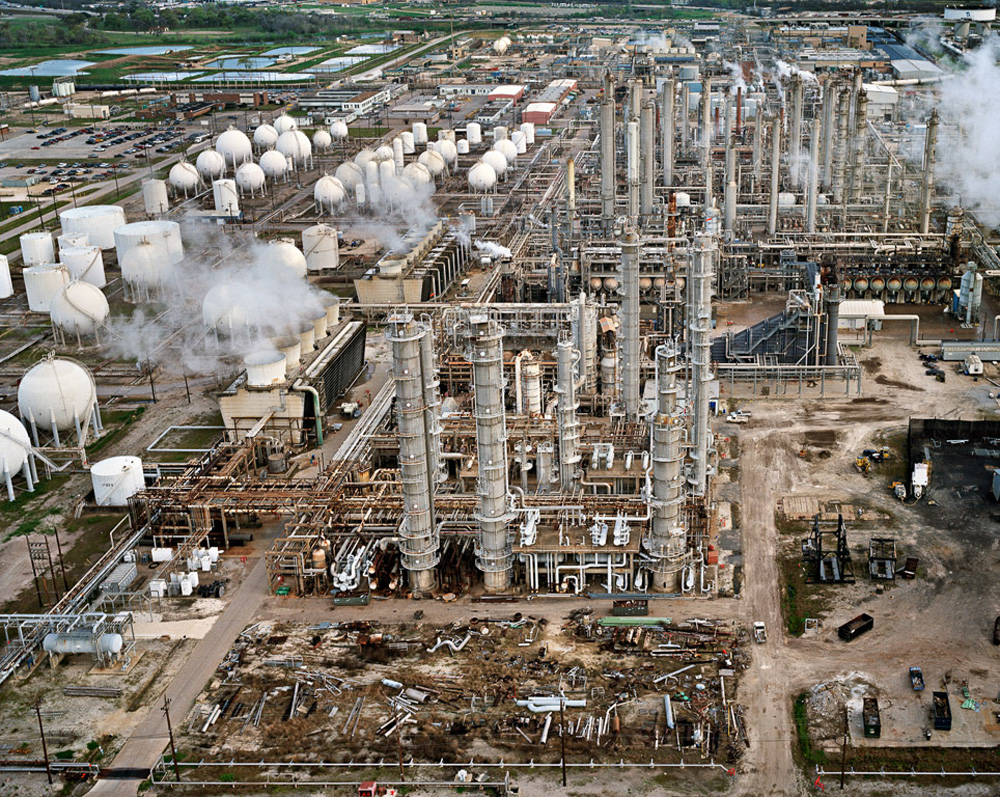
©Edward Burtynsky
And there is the other factor that people perceive the painter took longer to make that one painting?
I don’t think the time issue is as valuable as it used to be. It’s more about concept and visuals, and how you fit in — or what we might call in a post-modern world, how that work relates to what’s happening in the world. I think that creates a value in the artists and their work. I don’t think collectors are weighing how much time it takes to make. Value is a very interesting conversation. I think there are all types of markets, and the art market is probably the least understood, and suffers from the greatest amount of insider trading. You can’t even imagine. It’s quite an unregulated free for all. You can create value out of thin air, and it will disappear into thin air.
You have a Ukrainian background?
Yes, my parents were both Ukrainian.
And you still live in Canada?
Yes, I do. I happen to like it a lot more right now. Currently, with America, I think there is a lot of confusion happening there that needs to be sorted out. Yeah, I’m being too kind. But I think Canada is a great place where the conversations are really interesting, and the social relationships very healthy.

©Edward Burtynsky
It’s pro immigrant?
Canada is pro immigrant, pro integration, pro social services, and pro universal healthcare. We are pushing towards better access to education and housing, and working on big social issues in a way that is more collaborative. We also have a deep realization of the tragedies that happened with the indigenous people of Canada. We’ve gone through the Truth and Reconciliation Commission. The reports coming out are bad. We’re trying to deal with the indigenous cultures, go back, clean up the water and fund them properly and improve their education and health. I think that’s long overdue. We are one of the last great democracies that aren’t really being challenged right now. There’s certainly Scandinavia as well, but Europe, Britain, and U.S., have all been overtaken by populist tendencies.
People don’t know about Canada. It’s so big. People know as much about Scandinavia.
Correct, we are right next door, and we are America’s largest trading partner.
Back to your beginning as an artist — you were 22 when you started?
Yes, and I started working professionally as an artist right away — applying for grants. My first exhibition was in 1982.
You had a BFA?
I received a Bachelor of Applied Arts from Ryerson University. Ryerson had one of the best photography courses in the country. I was able to learn about the history of photography as well as art, literature, philosophy and psychology. It was a great foundation that gave me an overview of sociology and perception. Ryerson programming was a fabulous foundation for a curious mind.

©Edward Burtynsky
And you have just worked as an artist since then?
I also started a business, a print lab, which is still up and running. It has allowed us to keep a steady income and produce all my own prints from the lab.
What do you use to print?
Up to the 48-inches wide on the short dimension, I still use photo paper. I write onto Kodak photo paper.
Which means?
A digital writer. There’s a few of them: Lambda, Lightjet, and Chromira.
It’s not a true film enlarger?
It’s not an enlarger. Once I have a colour managed digital image file, it’s written onto analog photo paper. The writer is made here in California, and it’s called Chromira.

©Edward Burtynsky
That’s the paper?
That’s the machine, Kodak is the paper. The Chromira gives me the ability to write onto photo paper. I find when you write on photo paper, from a digital file, there’s still actual light hitting an emulsion, a sort of dispersion and texture that visually feels more like film. I like that, but for my big oversize prints, I’m now using Canon inkjet printer. I tried Epson, Canon, HP, and a few others, but Canon has given me the nicest rendition.
And the Canon uses?
Inkjet paper.
Film paper vs. inkjet, it’s pretty close?
I’ve managed to get them very close. You would be hard pressed to tell the difference.
So it’s been a big evolution in printing over the years?
I’ve been on the frontline of that world. We started in 1985 with just enlargers and color processors.
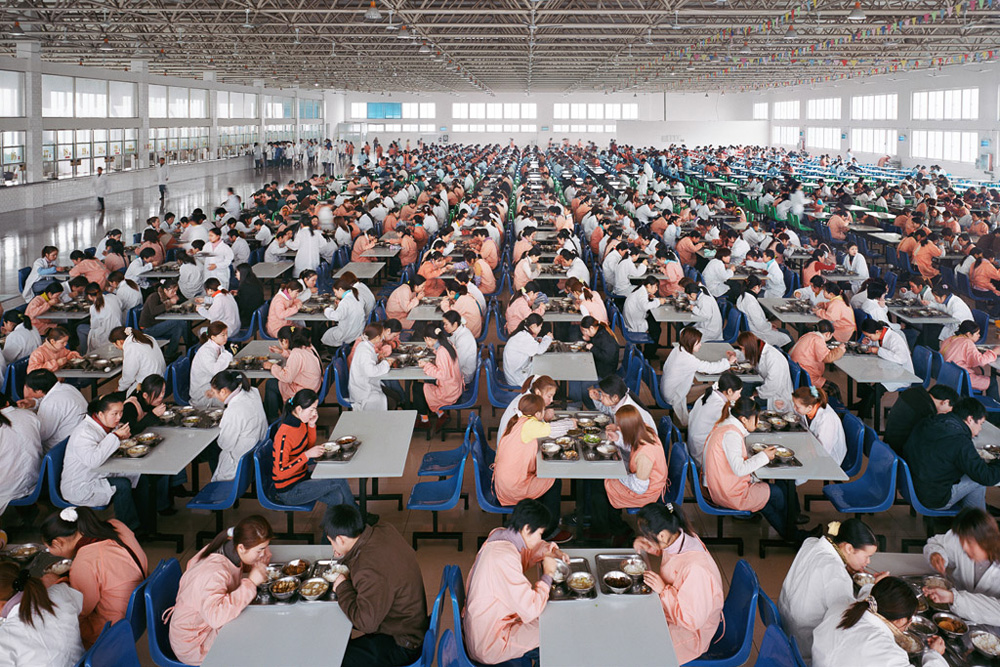
©Edward Burtynsky
And film.
Just film—that’s all there was. In 1992 I opened up the digital lab and ran the conventional film processing side at the same time. Just three years ago we shut down the film enlargers so it’s now strictly digital. It’s been a major paradigm shift over the past 30 years, very challenging.
Technically or getting clients?
It’s just hard to survive at all. As a lab operator you constantly have to compete with your own industry. Let’s say you print with an enlarger and now everybody else is going to digital printers. The guys who use enlargers now see you are developing a technique that’s going to put them out of work. So, in a way it’s kind of a proclamation: I’m finding a new way to do your job.

©Edward Burtynsky
And you have to always buy new equipment?
Well, no it’s the paradigm shift that is the issue. Let’s say I’m printing one way with an enlarger and a few lenses. That’s how I do it for 12 years. Now the world is going digital, and I’m going to take the enlarger out of the equation, so everybody who works on enlargers is out of a job, unless they learn to work in Photoshop. As a lab owner that’s the scenario I had to go through. You are literally cannibalizing one for the other; retraining some people and letting others go in order to keep up with the shift in technology — otherwise you don’t survive.
It’s like treading quicksand?
I call it a dual management problem: managing a sunset industry and managing a sunrise industry. You’re transitioning, maximizing your profit down to nothing on the sunset industry, and trying to make profits on the new operation, which is almost impossible because it’s so expensive. On the sunrise industry you are taking profits from your sunset industry, and investing. So during a paradigm shift it’s very hard to be profitable because everything you do make you have to invest in the new thing that’s coming.
Your clients are Canadians or Americans, or from all over?
Yes, London and Europe, but mostly local Canadians, as well as clients in New York and Seattle. The non-locals will often come down for a week or two to print a portfolio. The people we employ are sought-out printing technicians.
What originally attracted you to industrial landscapes? What inspired you?
By 1981 I started shooting mines, never thinking of them as a subject. It was kind of a curiosity. The back cover of my book Essential Elements, from 1981, was shot while thinking about abstract expressionism — the color feel, and palette. I was looking at landscape, and trying to compose with a large format camera with tightly compressed information. I wasn’t doing landscapes, but I was using landscapes to find a form that I like to work with. I kept trying to hone down to how a painter would look at the blank canvas, saying to myself, “how do I fill in via my piece of 4×5 film.”

©Edward Burtynsky
Most photographers go somewhere, and they see something and shoot it. You have your vision, and then you find where you can go get that vision?
It’s like a blank canvas. I’m trying to treat it like a canvas. What time of the year is it? Do I have to be there? What kinds of things am I looking for? Shooting the early mines was a real interesting period of training my eye and ideas. It was about having an idea, and then spending a lot of time in the world, as a sculptor would model with a ball of clay and use reality to turn it into something.
You have the idea before you find the scene?
Yes, I always work from the idea to the scene.
Your book Essential Elements is a compendium?
It spans my whole career thus far.
And you were a miner?
Yeah, I was a gold miner, and I worked in factories — Ford and GM.

©Edward Burtynsky
These were your day jobs before you fully became a photographer?
My father died when I was fifteen. My mother had zero money. I did two years at secondary school and college, then went into a four year program. The only way I could breakthrough was to fund myself. My summer jobs were whatever paid the most. Mining and factory jobs paid well. I worked labor and heavy-duty jobs—whatever paid the most. I was a big guy and I took direction well, so they would happily hire me.
That started the fascination of mines and quarries?
Yes. And then I recognized that there is a whole world that we become totally disconnected from. The camera is a fantastic vehicle that helps reconnect us with that world. When I started to think along those lines back in the early 1980s, I realized that this idea is big enough to spend the rest of my life doing it, and it’s inexhaustible. So, it’s reconnecting us to the world that produces the life that we have.
Would you say you’re trying to find beauty where most people don’t see it?
Well, I’m not looking for beauty. I’m looking with the same eye trained on what I apply to everything else I do. So, you can call it beauty or visually compelling imagery.

©Edward Burtynsky
Would you say you’re a painter in that way?
I started painting before I took up the camera. From when I was seven, I made oil paintings and landscapes. I just thought the camera was quicker. It was like painting, which I loved.
I thought this is a better way to do it. As a kid, I got a camera at eleven and ran around with this 35-millimeter camera. Unlike most kids, I was taking pictures and trying to understand what I was looking at conceptually in the three-dimensional world. I was always taking pictures trying to understand the relationship between seeing something in the real world, and flattening it onto a two-dimensional surface. I’m using the real world as a painter would use paint or a sculptor would use clay.
You have been shooting 4×5 and 8×10, but you are mostly digital now?
I’m pretty much all digital now.
And what is your preferred camera?
Up until a week ago, it was a 60 megapixel Hasselblad. I just received the 100 megapixel.
What’s the model?
Hasselblad H6D-100c with a 100 megapixel back.
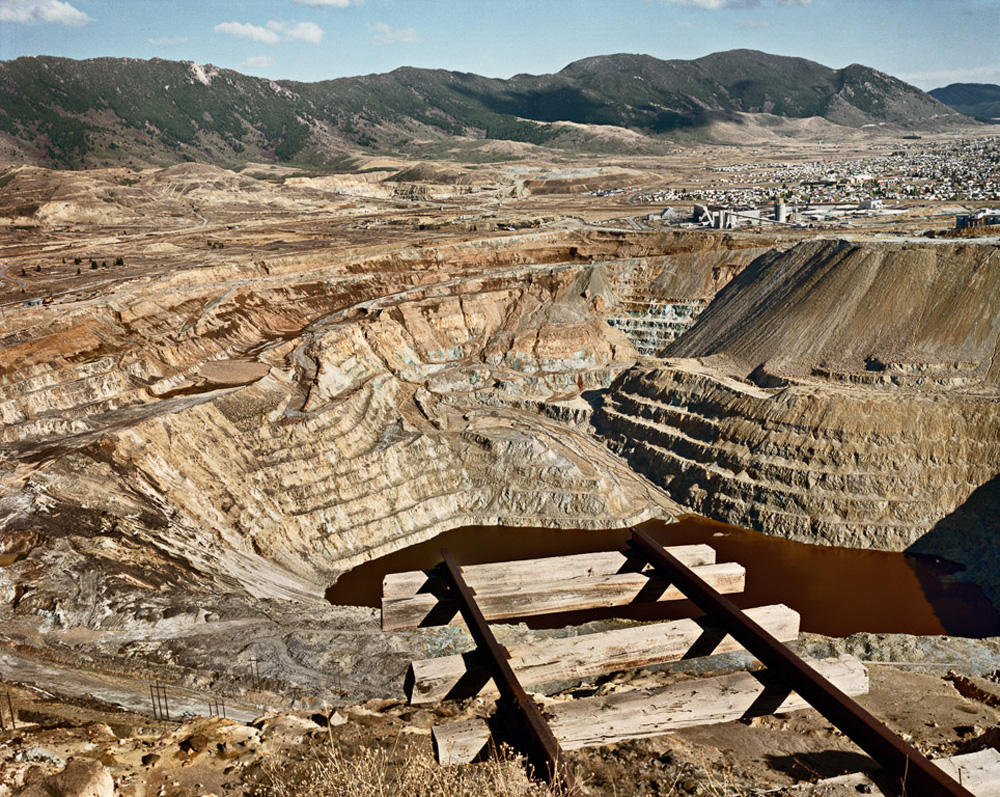
©Edward Burtynsky
Almost double.
Well, in terms of data, it’s sixty percent more data. Now with the 100 megapixel resolution, it’s like working with an 8×10 film camera.
You were matching 4×5 quality up till now?
What I’m doing now is beyond 4×5 with the 60 megapixel. I would say the 60 put me in a 5×7 format, and the 100 will bring me to 8×10 quality.
Do you have any issues with dynamic range? Why do you think people complain about the dynamic range with digital?
I haven’t got any complaints. The thing about Hasselblad, and their files, is that they’re 16 bit files. So, there’s a lot of color depth in them. That’s where they get really big flat files.
Detail in the blacks is good?
Every pixel is 16 bit so that’s a lot of detail. Every pixel can produce millions and millions of color. So it’s capable of great color fidelity and subtlety.

©Edward Burtynsky
You have been all digital for how long now?
Since 2010.
And it’s been liberating?
There was just so much equipment to lug around, and because I travel a lot, every time I hit security with my 4×5, they want to open up the exposed film—and your flight’s leaving. The stress of flying with film and going through 14 different security checks in places like Bangladesh or whatever—you’re just constantly doing battle.
And if you climb a mountain, it must be quite cumbersome with the large format.
Believe me, I love 4×5 and 8×10. There’s a real loss because of the ritual and slowness it brings. It’s like the slow food movement. By the time you get a tripod out and get your focus, framing, and exposure correct, you’re 20 minutes into it before you have your first shot. I can have my Hasselblad out on a tripod and be shooting in one minute.
Then you have to make sure you have the film properly loaded. You have to make sure your film doesn’t get too hot or too humid. You have to get it back home, through the borders to have to it processed. So, it’s a real discipline and a commitment to the materials.
Also, you don’t really know that you ‘have’ the shot, even after you’re back from your trip — until the film is in your hands. So, there has to be a mastery of materials and control. And also, if I didn’t get the contrast right, if the light was too flat, if there was anything imperfect on the film, then I’d have a problem with the print. I could only print film that had the perfect conditions, to make a great print.
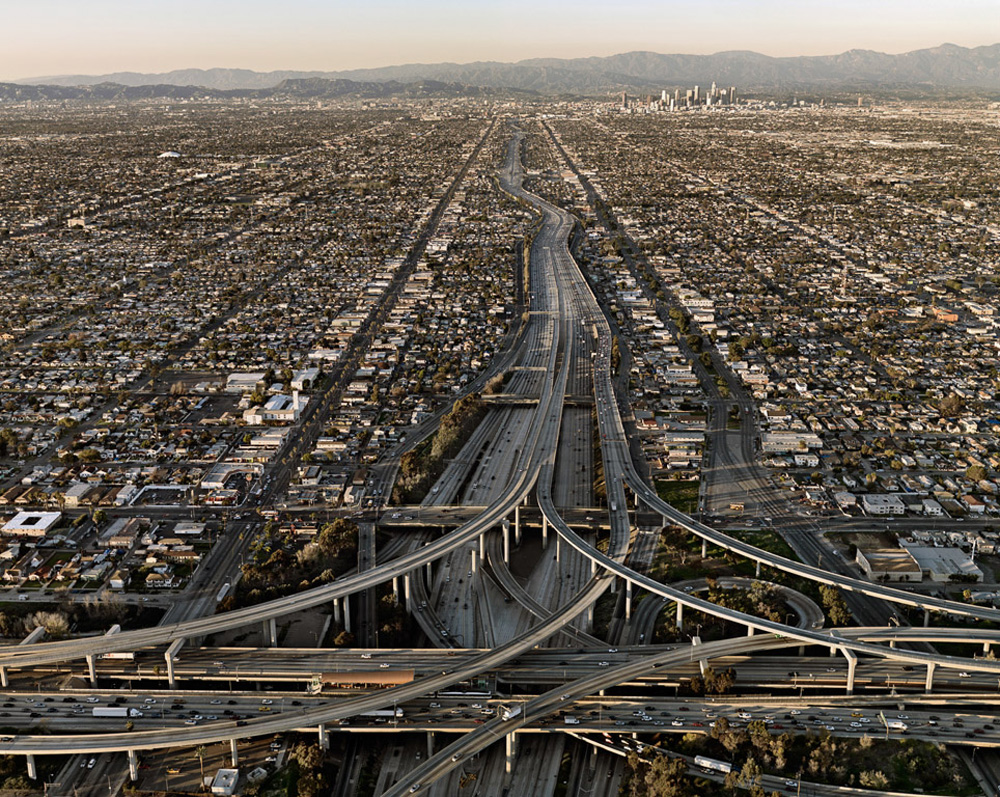
©Edward Burtynsky
And you were shooting print film?
Print film, I used a variety but mostly Kodak Portra.
So, there’s some latitude.
There isn’t latitude. If it’s contrasty, and the shadows are too deep, then there’s no picture.
The feel?
Yes, the feel of the light. You can fudge a lot of stuff but you can’t fudge the feel of the light. If it feels too contrasty or if it’s too flat you can’t fix it.
With all that said, do you think you may go back to film occasionally?
Now that I have a digital camera that’s as good as an 8×10, probably not. The films available now are much more limited. I still have all the film processing equipment. My daughter is buying a film camera because she thinks that it’s coming back, and it’s is the coolest thing. She’s trying to convince me today that I should go back too film and be cool. Be a hipster, Dad.
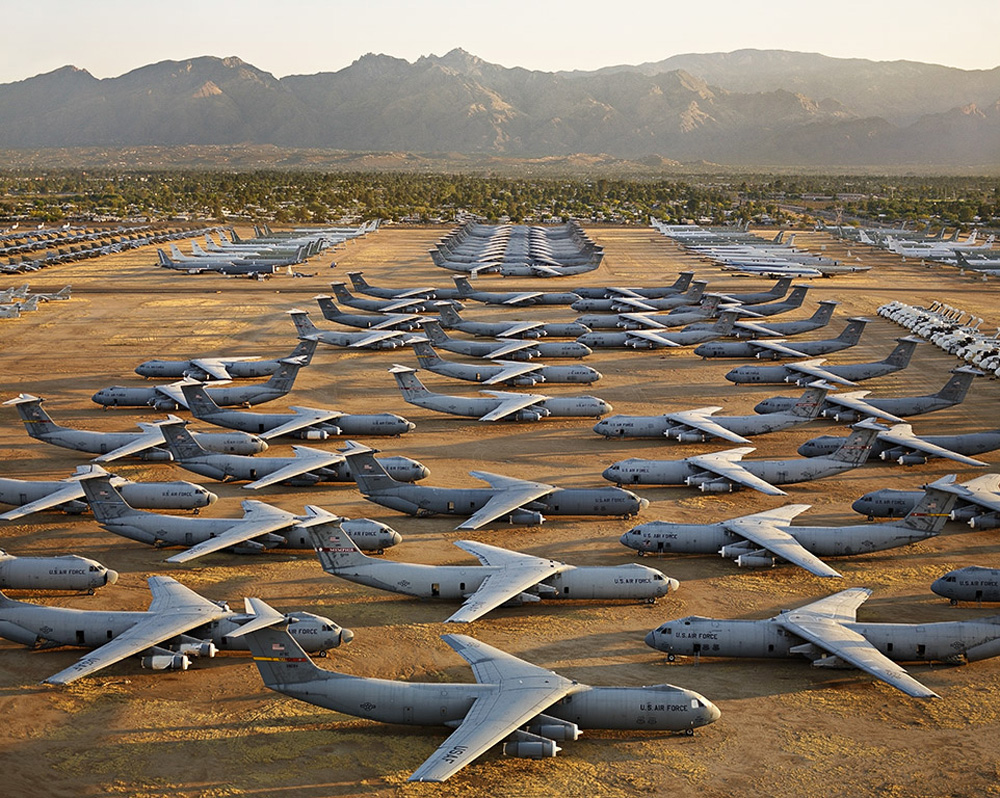
©Edward Burtynsky
She’s going to get a 35mm?
Yes, she wants a Pentax K1000 — something I had when I was a kid.
How do you decide on the size of prints you want? And why do you prefer C prints?
C [chromogenic] prints go back to the Chromira printer I told you about. That’s going from your digital file though a digital writer onto analog photo paper. It’s still the same chemistry that you had when you got your R prints from way back. My prints are 48-inches wide on color paper, beyond that, I go digital onto Inkjet.

©Edward Burtynsky
You have worked a lot in China. Is that one of your favorite countries to visit?
No.
Then how did you choose China?
Again, it’s through an idea and thinking, well where? The idea for China began a whole process in which I was interested in photographing a big dam. The Three Gorges Dam was the biggest dam by a factor of two. They were building a 27,000-megawatt dam in China —the Three Gorges Dam. I went there in 2002, 2003, and 2004. They poured concrete for 20 years to build that dam. It’s the biggest by a long shot. So, I went to China because I wanted to photograph that, and the Three Gorges was the place to go.
And you got more out of China than the dam?
Yes, then I started ‘seeing’ China. Once I figured out how to work in China, I started thinking, there’s a lot more going on: urban expansion, factories, and the whole transformation of their landscape, so I just kept going and I’ve been back maybe 14 times.
Was it harder or easier years ago?
When I went, it was hard to get in. But once I got in, it was pretty easy to run around and do whatever I wanted. Now they are a little bit more suspicious. They think, just why you want to shoot that?

Before they knew they were fascinating, now they don’t get it.
It’s just that everybody is more paranoid. There’s a general paranoia that exists everywhere. So, everybody is asking, why? Why are you’re looking at infrastructure? Why are you photographing our infrastructure?
And China has become more of a military power.
And there’s just more fear. Actually, I find photographing American infrastructure far more difficult.
The same suspicions?
More like, “we don’t want anybody seeing this.” I pull out Google Maps and say; everything is here on the map. If I was a terrorist, I can just go Google Maps. They don’t need my photographs. Then they go, oh we know that, but we just don’t want to encourage it. As a photographer it’s getting more difficult because the world is getting more paranoid.
What was Lagos, Nigeria like, and how long were you there?
I was there for two weeks. It was a challenging time, very difficult to work there.

©Edward Burtynsky
After reading the New Yorker article, I can’t really imagine what you went through and what it was like.
But at the same time, it’s not always holy-cow exciting. You’re sitting there a lot of the time just trying to get something done, and somebody is always trying to stop you. You’re just sitting there, and there’s a deadlock for days on end. So, you can’t move forward, but you try to work around that.
What’s an example of someone just irrationally trying to stop you?
There’s always something — like what’s in it for me? Why should I let you do it? You have to hit the right authorities. Oftentimes, the first answer I get whenever I shoot anything is “No” I want to shoot the dam. “No.” I want to shoot this. “No.” I start with “No” all the time. Oftentimes, it’s just about what is in it for the person approving, because if they approve it and it goes wrong, they have to deal with the authorities.
You have to soften their fears. If you look at my work, my work has never been about indicting industries or countries. I don’t go in as a journalist with an agenda. I don’t go in with a didactic proposal to point out what’s wrong with the way this country is doing something. So I have to work through all those fears that they have and demonstrate that my intention is not to deceive them. I’m not selling them out and getting them into trouble later.
As an artist, I sit in a carefully crafted position; that I don’t go after the people who have let me into those places, and say, you’re a bad player and you shouldn’t be doing that. If it isn’t Shell or BP taking their oil, it would be company A, B, or C. Somebody is going to do it so it doesn’t matter, it’s not really the company. It’s what we collectively allow the company to do, and the fact that we’re implicated in all of this.

©Edward Burtynsky
Did you use drones on the Nigeria trip?
There is one drone shot, but mostly it was from helicopters.
And you paid $2.00 a minute?
$2.00 a second. The only way I can rent a helicopter is to go in, which takes about 45 minutes, and I have maybe 40 minutes above the subject, and then I have to go back because we only have two hours of fuel. The problem when I went to Nigeria is that it was all oil-based companies. At first, no helicopter company wanted to fly me as a photographer for fear that I would do something that would piss off their client, which is Shell. So, if I do something and piss off Shell, Shell can ask “who got him out there? Who let him in there?” Then they find out that the helicopter company was complicit.
That’s why it’s so expensive?
It’s expensive because they only work with oil companies.
Oil companies and fine art photographers, and they don’t adjust the price.
I’m probably the only fine art photographer that ever came in.
And they don’t give you the student price?
It was $10.000 U.S. per hour.
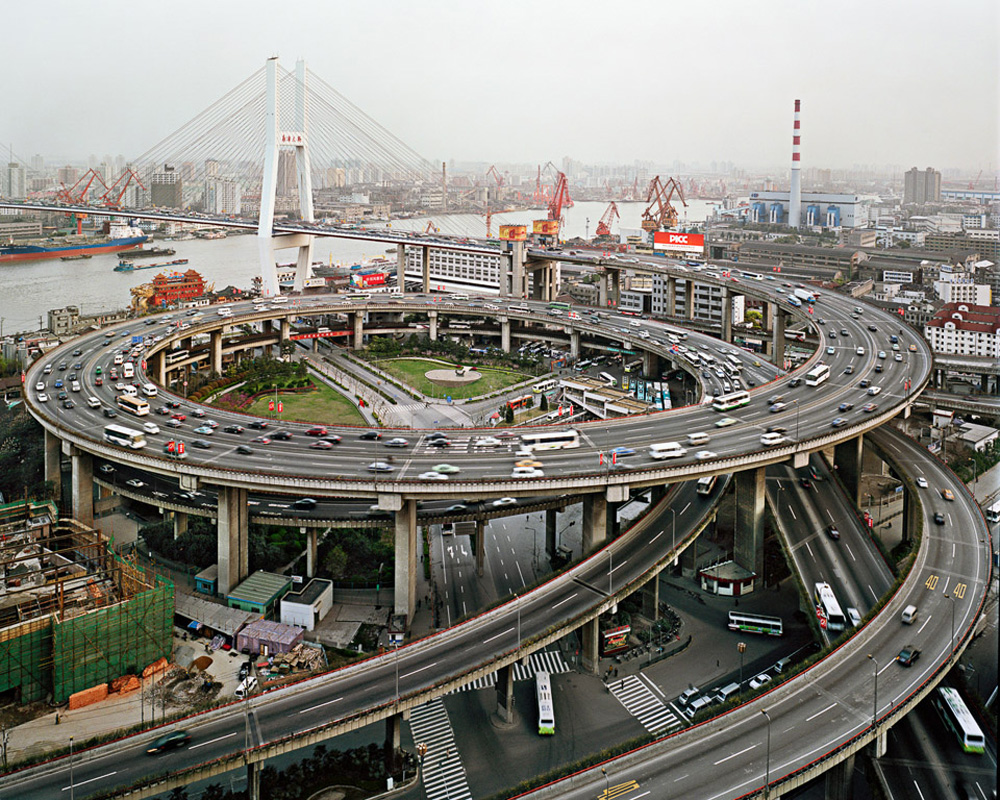
©Edward Burtynsky
Crazy.
I was doing the math when I was up there, because it takes 40 minutes to get there. And I’m thinking, it’s going to cost me $15,000 just to get in front of the subject before I start shooting.
And then another $15,000…
Yeah, and so, it was my most expensive shoot.
How was the Nigeria experience versus some of the other countries you have ventured to?
Well Nigeria is scary, whereas Bangladesh was never scary. People were friendly in Bangladesh. In Nigeria, you had to be extremely careful. I had body guards.

©Edward Burtynsky
Nigeria was scary for what? Kidnapping?
Yeah, kidnapping.
I heard that.
People kidnap, because you’re worth about 250k. There’s a price. You can actually buy kidnapping insurance.
You had that?
No, I looked at it, but I didn’t buy it. It would have cost $2,000. If you’re a backpacker with a grubby beard, and dreads, I don’t think they will be thinking, oh I can get $250,000 from you. But if you’re a director, and there’s drones and equipment, and you have an entourage, they might see you as someone of value. You have to be careful. For pilots, you’re always in a compound. You’re never allowed to go out by yourself on the streets in Nigeria because if you get nabbed, the oil company pays. The ransom is $250,000. You give them $250,000, and they let you go. It’s like a deal. That seems to be the number. So I didn’t choose to buy it, but I paid close to $30,000 for security.
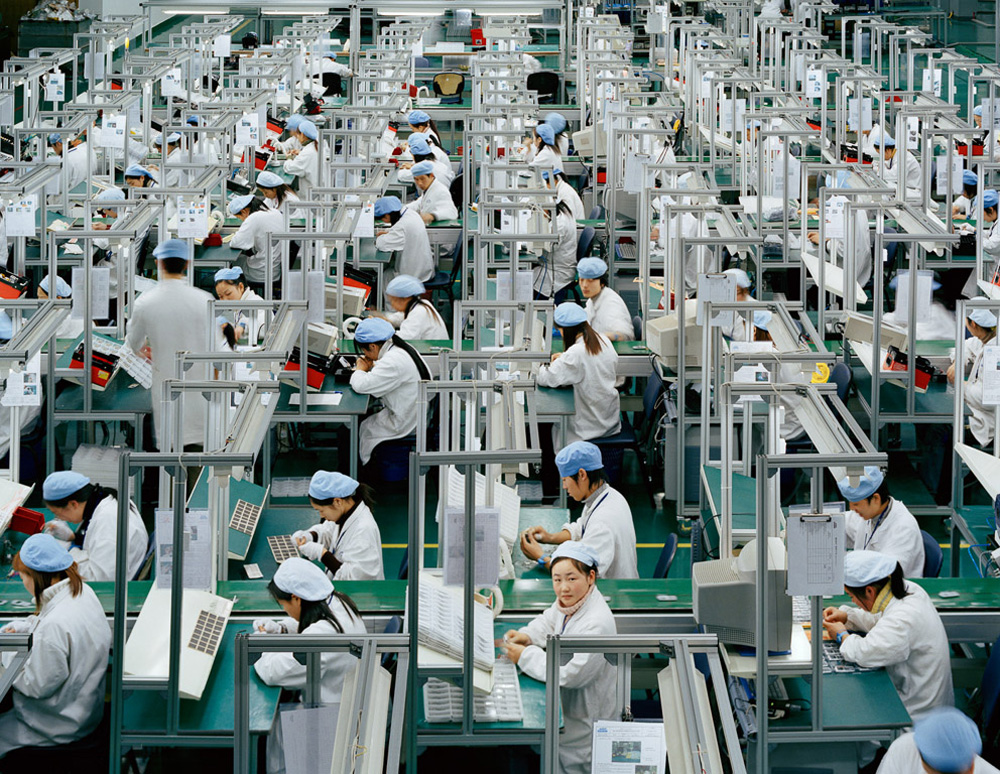
©Edward Burtynsky
Bangladesh was nicer?
Well, the people were friendlier. I mean I’ve worked a lot in Muslim countries, where they will give you their shirt off their back. They’re the friendliest people. They will invite you to their house, and give you whatever they’ve got regardless of their poverty.
You’re “the guest”.
Yes, and they are happy to share their food. So, I have nothing but say but good things about Bangladesh.
Finally, I really enjoyed your shipbreaking series. That’s a fascinating subject.
Yeah. It was the craziest thing I ever saw.
You don’t do it everyday. I was going to ask also, if you are interested in teaching?
I have done a little bit here and there, lecturing at universities.
As a permanent professor?
No, but I’ve been asked a lot of times.
It’s not your thing?
I don’t have time. I’m making films. I’m doing big projects and working in new technologies, I’m far more interested in my practice than in teaching. Maybe in a few years — if I feel like slowing down — but not now.
You have something coming up called Anthropocene?
That’s the newest project I’m working on, which is about how the epoch of mankind has, and is changing our planet. I’m looking at how we as humans are shifting Earth into the next geological age called the Anthropocene. We have the atmosphere building up CO2 and aerosol gasses. We also have a situation where a lot of deforestation is quickly and dramatically changing the landscape. We have a situation in the oceans where acidification, heating, and overfishing is happening—and coral is rapidly dying off.

©Edward Burtynsky
This fascinates you: the plunder and decay of the planet?
Look at our relationship to nature and how we use nature as a cupboard to just take what we need. We’re doing that at a level that’s unsustainable. But we’ve always gone to nature as part of the supply chain. Every molecule we have comes from nature. There is no other place. So, to me, it’s a relationship.
No one shows this extraction.
I know. So, I’m using art to reveal. Every picture speaks about either the material that’s been redeployed, like in cities or buildings, or where it originates or being converted from — the factories. But if you look at all my work, it’s always pivoting from that relationship.
How much do you care about legacy and being remembered?
I do think about fame. I’m leaving a huge body of work to the world and an estate. I have daughters. So, I do care about making and organizing my work in a way that makes sense and that is understandable. I have a fairly organized studio and an estate that I think is rational versus just a mess. A lot of others just have a mess. So, I care enough about my legacy in that it takes care of my estate in an organized way. Whether history remembers me or not is secondary, I mean I just do the best I can. I think what interests me as a human being is living a meaningful life. Self-actualization is at the top. I come up with ideas and then execute them. And I think that’s the real privilege in life. I take it as a privilege; I don’t take it for granted. I work as hard now as as I ever have.
That’s success.
You don’t ever lean back and say, “Oh, I got it done. It’s over now.”
And Finally, what would you say is the point of your work? What motivates you?
In the few short decades that I’ve been on Earth the population has gone from around 2.8 billion in the 1950’s to 7.5 billion. At current levels and trajectory of growth, industrialization and consumption there will no doubt be a global crisis of primary resource availability and an ecology-sink. I’m very concerned about the legacy our civilization is leaving behind and the sustainability of a decent quality of life for our descendants. All I’m trying to accomplish is make as many people as possible aware of where we are at, what that looks like, and where are headed. My motivation is to help inspire the broadest possible dialogue about these things.

©Edward Burtynsky

©Edward Burtynsky

©Edward Burtynsky

©Edward Burtynsky

Photo of Edward Burtynsky by © Ken Weingart
Ken Weingart has been producing interviews for his Art and Photography blog, and he has kindly offered to share a his interviews with the Lenscratch audience. Ken Weingart has worked and lived in New York City, Los Angeles, Italy, and Spain.
He has won numerous awards including being selected for the Communication Arts Photo Annual, and his editorial and advertising work has been widely published all over the world.
Posts on Lenscratch may not be reproduced without the permission of the Lenscratch staff and the photographer.
Recommended
-
Kevin Cooley: In The Gardens of EatonJanuary 8th, 2026
-
William Karl Valentine: The Eaton FireJanuary 7th, 2026
-
Sean Stanley: Ashes of SummerJanuary 6th, 2026
-
Nathan Bolton in Conversation with Douglas BreaultJanuary 3rd, 2026
-
Andrew Lichtenstein: This Short Life: Photojournalism as Resistance and ConcernDecember 21st, 2025












































































